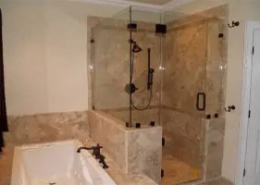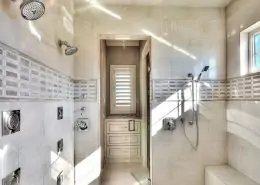Can You Safely Vent Bathroom Fan to Attic?
Tags
Bathroom Fan Vents to Attic | Vent Bathroom Fan Into Attic | Bathroom Fan Vent
Bathroom ventilation is a crucial aspect of maintaining a healthy and comfortable living environment. One common method of achieving this is by using exhaust fans to remove excess moisture, odors, and pollutants from the bathroom.
However, the question arises: can you safely vent a bathroom fan into the attic?
Let’s explore the reasons why you should not vent your bathroom fan into the attic, discuss alternative solutions, and ways to prevent condensation, and estimate the costs involved.
We’ll also touch on venting options for bathrooms with no window or outside access, helping you make an informed decision during the remodeling process.
Reasons Why You Should Not Vent Your Bathroom Fan Into The Attic
Venting a bathroom fan into the attic may seem like a convenient solution, but it can lead to several significant problems:
-
Moisture Buildup
The primary function of a bathroom fan is to remove moisture from the air. When you vent it into the attic, this moisture can accumulate and create a breeding ground for mold and mildew.
Over time, this can lead to structural damage and health issues.
-
Attic Insulation Damage
Moisture from the bathroom can damage insulation in the attic, reducing its effectiveness and potentially increasing energy bills.
-
Structural Damage
The moisture can also harm the wooden structure of your attic, leading to rot and decay, which can be costly to repair.
-
Odor Problems
Bathroom odors are not something you want to trap in your attic. They can infiltrate your living spaces and create an unpleasant environment.
-
Building Code Violations
Many building codes prohibit venting bathroom fans into the attic due to these potential issues. Violating these codes can lead to fines and complications during property inspections or when selling your home.
Alternatives To Venting Bathroom Fan Into Attic
If venting your bathroom fan into the attic is not a safe and effective solution, what alternatives can you consider?
Exterior Ventilation
The most common and recommended method is to vent the bathroom fan directly outside your home.
This can be achieved through a wall or roof vent. This approach ensures that moisture and odors are expelled from your living space, preventing attic-related problems.
Ductwork to an Eave or Soffit
If it’s challenging to vent through the roof or wall, consider routing the ductwork to an eave or soffit vent. This still allows for exterior ventilation while avoiding complex roof penetrations.
Ventilation Through the Roof
If you opt for roof ventilation, ensure that it is done correctly to prevent leaks. Professional installation is often the best choice.
Window Fans
If your bathroom has a window, consider using window fans. These fans can be installed temporarily and offer effective ventilation.
Ductless Bathroom Fans
Ductless fans use filters to purify the air before recirculating it into the bathroom. While they may not remove moisture as effectively as ducted systems, they are a viable option for bathrooms without suitable venting options.
Ways To Stop Condensation When Venting Into Attics
If you must vent your bathroom fan into the attic due to limited options, there are measures you can take to mitigate condensation and moisture-related issues:
- Install an insulated duct for venting. This helps to prevent the warm, moist air from condensing as it travels through the duct.
- Ensure that all joints and connections in the ductwork are sealed properly to prevent air leaks that can introduce moisture into the attic.
- Properly insulate the attic to reduce temperature differentials between the bathroom exhaust and attic air. This can help minimize condensation.
- Regularly clean and maintain your bathroom fan to ensure it’s functioning efficiently and expelling moisture as effectively as possible.
- Keep an eye on the attic for any signs of moisture or mold growth. Catching issues early can prevent costly repairs down the road.
How Much Will It Cost To Install An Exhaust Vent?
| Vent Type | Estimated Cost Range |
| Wall Vent | $150 – $300 |
| Roof Vent | $300 – $600 |
| Ductwork | $300 – $800 |
| Professional Installation | $200 – $500 |
| Ductless Fan | $100 – $300 |
Can I Vent A Bathroom With No Window Or Outside Access?
Bathrooms without windows or outside access can pose a challenge when it comes to ventilation. However, there are still viable options:
If possible, route ductwork through the walls or ceiling to reach an exterior wall or the roof. This may require professional installation but is the most effective way to ensure proper ventilation. Consider installing a ductless bathroom fan with a charcoal filter. While not as efficient as exterior ventilation, these fans can help remove odors and some moisture from the air.
If your bathroom has a small window or an operable skylight, you can install a window fan that exhausts air to the outside. Make sure to use a fan designed for this purpose. In cases where exterior venting is not possible, improving internal air circulation can help reduce moisture and odors. Use a combination of a ceiling fan and a standalone air purifier to achieve this.
Consult a Professional: If you’re unsure about the best solution for your windowless bathroom, consult with a professional HVAC contractor. They can assess your specific situation and recommend the most suitable ventilation option.
Are You Ready To Vent Your Bathroom?
Proper bathroom ventilation is crucial during bathroom remodeling in Houston to maintain a healthy and comfortable living space. While venting your bathroom fan into the attic may seem convenient, it can lead to significant issues over time. It’s essential to explore alternative venting options, including exterior vents, ductwork installations, or ductless fans, to ensure that moisture and odors are safely expelled from your home.
When deciding on a ventilation solution for your bathroom remodeling project in Houston, consider the associated costs, the specific requirements of your bathroom, and any relevant building codes in the area. If your bathroom lacks windows or outside access, consult with a professional to determine the most effective ventilation method while minimizing the risk of moisture-related problems.






















